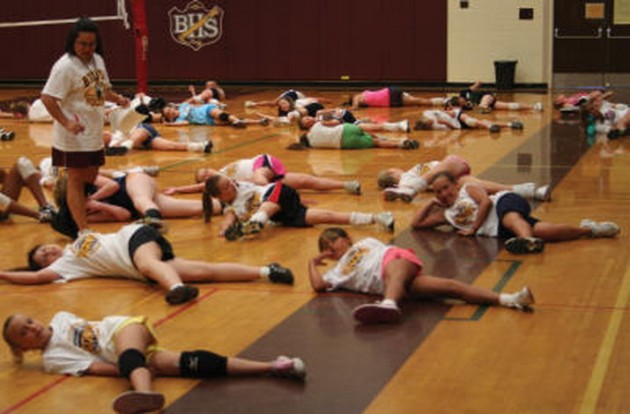
Volleyball Team Stretching
The cardio elevates your body temperature and increases blood flow. Stretching loosens up the muscles and joints. However, recent studies conducted at the University of Nevada, Las Vegas suggest that the traditional warm-up may not be getting the job done.
According to the study, stretching muscles while in motion – often called dynamic stretching – increases power, flexibility and range of motion far more efficiently than static stretching. An effective warm-up should do three things:
-Elevate body temperature
-Loosen muscles and tendons to increase the range of motion in various joints
–Increase blood flow throughout the body.
Implementing dynamic stretches into your workout and warm-up routine will aid injury prevention and increase your power and flexibility. A dynamic warm-up is most effective when it is a sport-specific warm-up that engages the athlete in movements that activate the joints and muscle groups that will be used during the activity. This guide will review a few of the stretches that are pertinent to volleyball, pointing out the area that is worked and the potential benefits for each stretch.
Warm-up Exercises
Stretching is most effective when your muscles are warm and your body temperature is elevated. Failure to warm up the body correctly before beginning a dynamic stretch routine could result in injury.
A light five-minute jog or jumping jacks are great examples of warm-up exercises, but anything that elevates the body temperature and gets the blood pumping is a sufficient warm-up.
Ankle Flips
The purpose of the ankle flip is to activate the ankle joint and promote increased range of motion in the ankle joint. When executed correctly, the ankle flip also strengthens the ankles. This allows for more efficient lateral movement and more explosive power off the ground (that means you’ll be able to jump higher).
To perform the ankle flip:
1. Start with the feet shoulder-width apart. The weight should be primarily on the balls of the feet. The athlete’s legs should be straight so that the knee does not appear to be visible.
2. In an explosive movement, the athlete will propel the body forward by pushing off the ball of their right foot and flexing the ankle in mid-air. Once the right foot has landed, the athlete will repeat the movement with the left leg.
3. The athlete is propelled forward only by the flexion of the ankle.
Russian Kicks
This exercise is designed to help loosen the hip joints and increase the blood flow in the lower half of the body. Though often overlooked, the hips and the core are primary sources of power for the volleyball athlete.
To perform Russian Kicks:
1. Start with feet shoulder-width apart, the knees slightly bent and the core engaged.
2. Kick one leg straight out in front of you. The toes of your airborne leg should be flexed towards the sky. As you kick your leg out, reach your opposite arm out to your toes.
3.Drop your leg and repeat with opposite limbs.
Over-Unders
The best way to describe the over-under exercise to your athletes is to tell them to imagine they are lifting one leg to step over an imaginary hurdle and then stepping under the hurdle. This stretch is a great way to continue to loosen the all-important hip joint. It is particularly good for hip stabilization and promoting balance.
To perform over-unders:
1. Start in an athletic position and bring your right leg to your chest.
2. Extend your right leg over an imaginary hurdle and place it down on the other side of the hurdle. Once you have stabilized your right leg, bring your left leg over the imaginary hurdle in the same fashion as your right leg.
3.Once both legs are over the hurdle, reset yourself. Then take your left leg and place it under the hurdle as if you were attempting to go under the hurdle without having your back touch any part of it.
4. Have your right leg follow your left leg.
Handwalks
This exercise helps loosen the shoulder joints while simultaneously stretching the hamstrings. Because athletes must engage the core while performing handwalks, the athlete becomes aware of how integral the core muscles are.
To perform handwalks:
1. Stand straight with your legs together.
2. Bend over until both hands are flat on the ground.
3. Walk with your hands forward until your back is almost extended.
4. Keeping your legs straight, inch your feet toward your hands, then walk your hands forward again.
5. Repeat five to six times.
Scorpion
The scorpion stretch engages the lower-back muscles, hip flexors and glutes. Though the lower back is often overlooked in favor of abdominal muscles, it is important to remember to stretch and strength the back muscles because they are part of the core. This exercise does just that.
To perform the scorpion:
1. Lie on your stomach, with your arms outstretched and your feet flexed.
2. Only your toes should be touching the ground.
3. Kick your right foot toward your left arm, then kick your left foot toward your right arm
4. Repeat up to 12 times.
Say Goodbye to Inflexibility
Implementing dynamic stretches into your workout and warm-up routine will aid in injury prevention and increase your power and flexibility. So get out on the court and give the exercises listed above a try. The only thing you have to lose is a lack of flexibility.
Read more articles from our Stretching section.
Check out our Physiotheraphy section, every Monday a new story! Tomorrow read about Runners knee – A Common Cause of Knee Pain